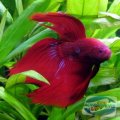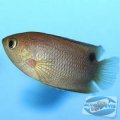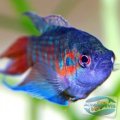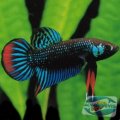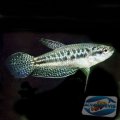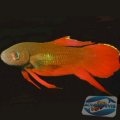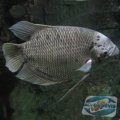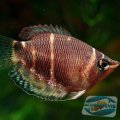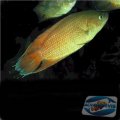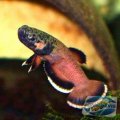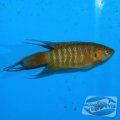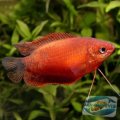Deissner's Licorice Gourami / Parosphromenus deissneri
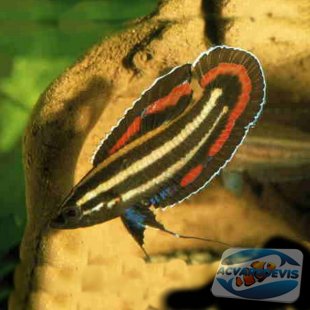
- Dificultate: Moderata
- Acvariu minim: 45.4 Litri
- Dimensiune: 3-4 cm
- Apa: Dulce
- pH: 5.6 - 7.2
- Temperatura: 24 -28 °C
- Duritate: 6-10 °d
- Raport sexe: 1:1 M:F
- Raspandire: Neobisnuit
- Dieta: Omnivor, hrana vie, granule, fulgi
- Durata de viata: 3-5 ani
- Habitat: Asia
- Familie: Osphronemidae
Dimorfism sexual: Femelele sunt mai mari si mai putin colorate decat masculii.
Inmultire: Perechea trebuie hranita variat pentru a stimula depunerea. Masculul va construi un cuib de spuma in o ascunzatoare. Dupa un ritual de imperechere activ, femela va depune circa 100 icre. Dupa depunere masculul va alunga femela si va ingriji icrele, apoi puii. Icrele vor ecloza dupa trei zile iar dupa alte 3-4 zile vor putea inota. In acast moment puii trebuiesc separati de adulti si hraniti cu nalupi de Artemia. Acestia sunt sensibili la poluanti, a se evita suprahranirea, vor creste lent.
Ingrijire: Necesita acvarii bine plantate, slab iluminate si cu plante de suprafata. Substratul trebuie sa fie inchis la culoare. Pestii au nevoie de ascunzatori confectionate din pietre sau ghivece. Filtrarea trebuie sa faca un curent cat mai slab in acvariu.
Hranire: Trebuiesc hraniti cu hrana variata, se poate folosi Daphnia, Artemia, Cyclopi, Tubifex, fulgi sau granule.
Comenatrii: Aceasta specie trebuie tinuta in perechi, preferabil in acvarii specifice dar poate fi tinuta si in acvarii comunitare impreuna cu alti pesti mici, pasnici.
LABYRINTH FISH Licorice Gourami - Parosphromenus deissneri
Licorice Gourami, Deissner's Licorice Gourami [Pictures] Parosphromenus deissneri Synonyms: Osphromenus deissneri Physical description: An elongated, moderately compressed species with a colorful, fan-shaped caudal fin. The dorsal and anal fins each have long bases. The body is dark brown with two yellowish lateral stripes running from the the snout to the caudal fin. Occasionally these stripes are reddish. The pelvic fins are bright blue as is the front part of the anal fin. The rear part of this fin is red, while the edging is light blue. The caudal fin is dark brown with a red semi-circular stripe. This fin is also edged in blue-white. The dorsal fin is brown with a stripe. This stripe begins as blue but becomes red near its rear. This fin also has a white-blue edging. Size/Length: To 1.5" (4 cm) Similar species: Thread fin or Spike tail Licorice Gourami ( P. filamentosus), Nagy's Licorice Gourami (P. nagyi ), Pygmy Licorice Gourami ( P. parvulus) Habitat: Slow-moving black water in marshes, ponds, and lakes in Southeast Asia; southern Malaysia S: bottom, middle Aquarium: A tank measuring 20" (51 cm) with a capacity of 10 gallons (38 L) is sufficient. The tank should be dimly lit with a cover of floating plants. The substrate should be dark, and the tank should be heavily planted. Provide at least one hiding place for each fish. The filtration system should create little or no current. Shallow tanks having peat filtration are preferred. Water chemistry: pH 5.5-7 (6.4), 1-8°dH (4), 75-81°F (24-27°C) Social behavior: A timid and peaceful species that should be kept in pairs. This species does best in a species tank, although it can be combined with other small, clam fish. Suggested companions: Other Parosphromenus , Pangio , Corydoras, Trichopsis, Loricarids. FOOD: This species requires a varied diet of live foods. Live; Daphnia, Artemia, Cyclops, Drosophila, whiteworms, Tubifex ; flakes Sexual differences: Females are larger and less colorful. Breeding techniques: Use water with a pH from 6.2-6.8, a water hardness from 1-4°dH, and a temperature from 79-82°F (26-28°C). The pair should be fed a varied diet. A bubble nest is built by the pair in a cave. After an active courtship, the relatively large eggs are attached to the ceiling of the cave. Each pairing produces 7-15 eggs until 40-100 are laid after two hours. The male then chases off the female and assumes brood care. The eggs hatch after three days, but the fry remain in the nest for 3-4 more days. The fry should be removed, and transferred to a rearing tank. The fry are sensitive to water pollutants, and should be raised with newly hatch Artemia nauplii. The young grow slowly. Breeding potential: 8. Breeding is difficult. Remarks: Like other Licorice Gouramis, P. deissneri rarely surfaces for air at the water surface. This species requires favorable water conditions in order to display its stunning coloration. Thus, in dealers' tanks, its colors are rarely present. Difficulty of care: 7. This sensitive species should be kept to a pair in a tank of their own.
|
